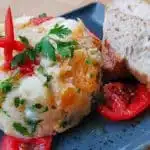We are bringing Spain to your favorite cup! Our Spanish cafe con Leche recipe will have you making this Spanish cafe staple regularly at home.
Our easy cafe con Leche recipe will have you making this hot drink at home in no time. Simply make a shot of espresso, heat some milk, combine the two, and have a Spanish coffee that is both energizing and satisfying.
What is Café con Leche?
The direct English translation of the Spanish name cafe con Leche is “coffee with milk.” It is truly what it says it is – a shot of espresso combined with milk.
Cafe con Leche is a typical drink in Spanish cafes and homes. You see locals drinking it whatever time of day it is. Sometimes, breakfast is entirely skipped, and a big cup of cafe con Leche will suffice!
Read also: The most popular Spanish Drinks

History of Cafe con Leche
Where did cafe con Leche originate? This beverage is from Spain, although no one can pinpoint who created it and how this coffee drink was first made.
Until now, cafe con Leche is widely popular in Spain, in many Spanish-speaking communities, and basically in every coffee-loving part of the world.
Here are some of the equally popular coffee drinks in Spain:
- Cafe cortado – A shot of espresso with a splash of milk. The Spanish word cortado in English means “cut.”
- Cafe Carajillo – A shot of espresso with rum, whisky or brandy. It is often called Spanish coffee.
- Leche manchada – Warm milk with a splash of coffee. The Spanish word manchado in English means “stained.”
- Cafe bonbon – A shot of espresso with some sweetened condensed milk
Tips to prepare the best Café con Leche
- When it comes to the water…
Make sure to use clean water. Do not use water that comes directly from your sink if it is not ready to drink. If you have it available, opt for filtered water.
Bottled water can also be good for making cafe con Leche (and any other coffee, for that matter). Just stay away from types such as distilled.
- When it comes to the beans…
Use your favorite blend! Grind your coffee beans just before you need them. This ensures that you have a fresh cup of cafe con Leche. Fine grind is best when making an espresso.
- When it comes to the machine…
Good espresso is the foundation of a Spanish cafe con Leche recipe. This does not mean that you must have a professional espresso machine at home, though! If you have a stove-top espresso maker, an electric Moka pot, or a savvy Nespresso machine that gives a shot of espresso that is to your liking, you have this in the bag!
- When it comes to the milk…
Choosing the right type of milk to use for your Spanish cafe con Leche is important. Whole milk is what is often used in making this hot drink. You can substitute whole milk with the milk of your choice, such as plant-based milk, but it will not taste the same as a traditional cafe con Leche.
When heating the milk, you only want it steamed; it doesn’t need to boil. You can heat the milk in a pot over the stove, or you can also conveniently use a microwave.
- When it comes to the ratio…
Normally, a Spanish cafe con Leche recipe would call for equal parts of coffee and milk. Feel free to adjust this ratio according to your preference. You can ask for “clarito,” which means more milk, or “oscurito,” which means less milk in Spanish cafes.
- When it comes to serving…
You can add a dash of cinnamon to your cafe con Leche before serving. This is typically done in Spain. You can also add some sugar if you like your coffee sweet.
Cafe con Leche Ingredients
For the espresso, you need:
- Finely ground coffee
- Water
For the cafe con Leche, you need:
- Espresso shot
- Steamed milk
- Cinnamon (optional)
- Sugar (optional)
Frequently Asked Questions about Spanish Cafe con Leche
What does cafe con Leche have?
Traditionally, cafe con Leche only has three ingredients: ground coffee, water for the espresso, and steamed milk.
Is Cuban coffee the same as cafe con Leche?
Cuban coffee is not the same as cafe con Leche. When making Cuban coffee, you pour a bit of the espresso into some sugar so you can make what they call an espuma which is some form of coffee foam. You do not have this process when making cafe con Leche.
What is the difference between a latte and a cafe con Leche?
Cafe latte has way more milk than Spanish cafe con Leche. There is also a thin layer of milk foam on top of a cafe latte, while there is none in a Cafe con Leche. The coffee-to-milk ratio of a latte is 1:2 while a cafe con Leche is 1:1.
What flavor is cafe con Leche?
Cafe con Leche has no specific flavor, although most people serve it with a dash of cinnamon. For taste and texture, a Spanish cafe con Leche can be best described as creamy and thick.
Are cafe au lait and cafe con leche the same?
Cafe au lait and cafe con leche are the same. The French cafe au lait also makes use of a shot of espresso and steamed milk. Both also have a coffee-to-milk ratio of 1:1.
Spanish Cafe con Leche Recipe
Spanish Café con Leche Recipe

Ingredients
- 1 shot or 1 oz (30 ml) of espresso
- 1 oz (30 ml) of steamed milk
- Cinnamon (optional)
- Sugar (optional)
Instructions
1. Prepare your espresso with your preferred method. You can use a stove-top espresso maker, an electric Moka pot, a Nespresso machine, or a proper espresso machine – whatever you have at home!
2. Steam your milk over the stove or with the use of a microwave. Take it off just before the milk starts to boil.
3. Pour the milk over your espresso shot.
4. Optional: Add a dash of cinnamon and some sugar to taste. Enjoy your Spanish cafe con Leche!
Nutrition Information:
Yield:
1Serving Size:
1Amount Per Serving: Calories: 150Total Fat: 5gSaturated Fat: 3gTrans Fat: 0gUnsaturated Fat: 2gCholesterol: 20mgSodium: 132mgCarbohydrates: 19gFiber: 1gSugar: 4gProtein: 9g
The nutritional information provided is approximate and can vary depending on several factors, so is not guaranteed to be accurate.


Leave a Reply